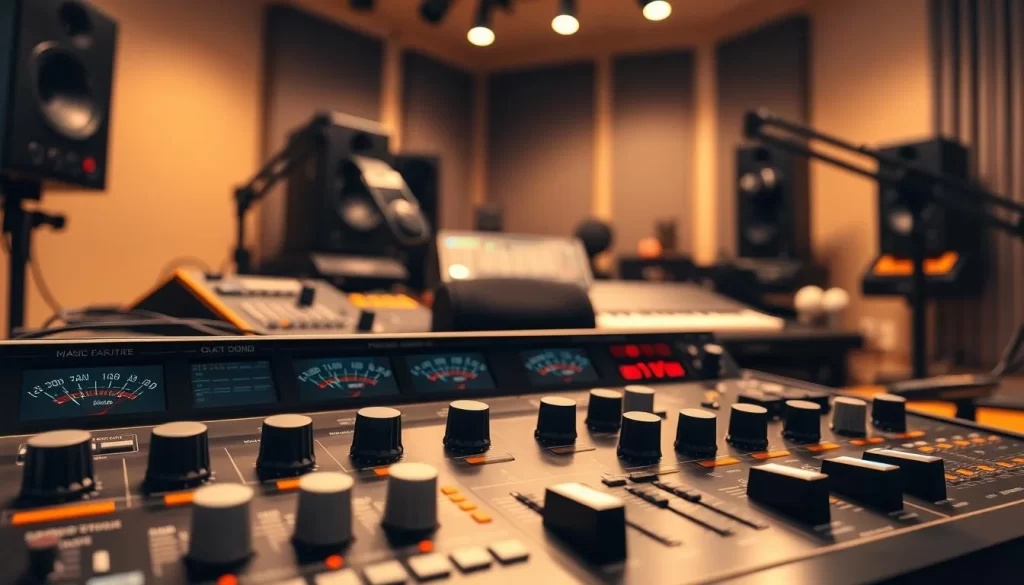Ever wonder why professional shows sound so crisp and clear? The secret lies in audio compression, a behind-the-scenes technique that polishes raw recordings into smooth, balanced sound. While listeners enjoy seamless listening experiences, creators know the magic happens in the details.
Top-tier productions like NPR and Gimlet Media use compression to maintain consistent volume levels. This ensures whispers and laughter stay audible without sudden spikes. The goal? Make technical adjustments invisible while keeping the natural feel of the conversation.
In this guide, I’ll break down how compression works and why it’s essential for dynamic range control. Whether you’re a beginner or refining your skills, these tips will help you achieve studio-quality results effortlessly.
Key Takeaways
- Compression balances volume for a professional sound.
- Top shows like NPR use it to enhance clarity.
- It smooths out loud and soft moments seamlessly.
- The best compression goes unnoticed by listeners.
- Practical techniques make editing easier.
What Is Audio Compression and Why Does It Matter?
Ever cranked up your car radio to hear quiet dialogue, only to get blasted by sudden laughter? That’s dynamic range—the difference between the loudest and softest parts of your audio. Without control, these swings force listeners to adjust volume constantly.
Defining Dynamic Range in Audio
Think of dynamic range like a rollercoaster. Quiet moments (whispers) are the valleys; loud bursts (laughter) are the peaks. Measured in decibels (dB), wider ranges sound natural but frustrate listeners. Narrower ranges feel polished.
Radio stations use extreme compression to squash music into a tight volume box. For spoken content, moderate settings work better—preserving emotion while avoiding fatigue.
The Role of Compression in Professional Sound
A compressor acts like a volume referee. It tames loud peaks and lifts quiet moments using two key settings:
| Setting | What It Does | Example Value |
|---|---|---|
| Threshold | Volume level where compression kicks in | -12 dB |
| Ratio | How much peaks are reduced (e.g., 4:1 = every 4dB over becomes 1dB) | 3:1 |
Tools like REAPER’s ReaComp plugin visualize this. Set the threshold where peaks start, and adjust the ratio to smooth them gently. The result? Consistent vocals that sound natural in any environment—car speakers, earbuds, or smart devices.
Why Your Podcast Needs Compression
Nothing ruins a great conversation like sudden, jarring volume changes. Listeners hate constantly adjusting their devices to hear whispers or duck loud bursts. Compression smooths these extremes, creating a seamless experience.
Listener Experience: Avoiding Volume Jumps
Picture this: you’re driving while an uncompressed episode plays. The host’s quiet musings vanish under road noise, but their laughter blasts at 200% volume. With compression, both stay comfortably audible.
Headphones amplify the problem. Sharp spikes cause ear fatigue, while quiet parts get lost. A -16 dB threshold with a 3:1 ratio keeps everything balanced. Bonus? It tames background noise like AC hums or mic bumps.
Consistency Across Episodes and Voices
Guests often have wildly different vocal dynamics. A soft-spoken expert might need a lift, while an energetic host requires gentle peak control. Compression settings act as an equalizer:
- Template presets save time. Apply the same -12 to -6 dB sweet spot across episodes.
- 190ms release time prevents over-compression, preserving natural speech rhythms.
- Balanced podcast audio means listeners focus on content, not technical flaws.
The result? Professional sound quality that builds audience trust—one consistent episode at a time.
How to Use Compression in Podcast Editing
Want your voice to sound polished without hours of tweaking? The secret is choosing the right compressor and nailing the basic settings. Let’s break it down.
Choosing the Right Software for Your Needs
Not all tools are created equal. Here’s a quick comparison:
- Hindenburg Journalist: One-knob simplicity for beginners.
- Waves C4: Multiband control for advanced users.
- ReaComp (REAPER): Detailed customization with visual feedback.
Free options like Audacity work, but lack precision. Paid tools like Adobe Audition offer presets for faster workflows.
Step-by-Step: Applying Your First Compressor
In REAPER with ReaComp:
- Set the threshold to -16 dB (where compression starts).
- Choose a 3:1 ratio to smooth peaks gently.
- Watch the waveform meter—aim for 3–6 dB of reduction.
Pro tip: Avoid smartphone recordings. Built-in compression often distorts vocals unpredictably.
With these settings, your audio will sound balanced—no listener fatigue, no missed whispers.
Key Compression Settings to Adjust for Perfect Sound
Mastering volume control is like having a secret weapon for professional sound. Tiny tweaks to your compressor can transform erratic audio into a smooth, listener-friendly experience. Here’s how to fine-tune the critical settings.

Threshold and Ratio: Finding the Sweet Spot
Think of the threshold as a bouncer. It decides which sounds get into the “compression club.” Set it at -12 dB to catch only the loudest peaks. The ratio then controls how much those peaks are tamed:
- 3:1: Gentle leveling for natural conversations.
- 5:1: Stronger control for chaotic recordings.
Watch your meter—aim for 3–6 dB of reduction. Too much squashes the life out of your signal.
Attack, Release, and Makeup Gain Explained
These settings refine how your compressor reacts:
| Setting | Purpose | Ideal Value |
|---|---|---|
| Attack | How fast compression kicks in | 10ms (prevents over-reaction) |
| Release | How fast compression stops | 190ms (avoids pumping) |
Makeup gain boosts the overall volume after compression. Add 4–6 dB to hit the -16 LUFS loudness standard. Just avoid the “red meter” zone—constant compression kills dynamics.
Conclusion: Elevating Your Podcast’s Sound Quality
Great audio isn’t just about clarity—it’s about keeping your audience engaged. Over-compressed tracks sound flat, like AM radio, while balanced dynamics feel vibrant and natural. Periodically bypass your tools to check if vocals retain their authenticity.
Pair compression with noise reduction or EQ for a full production polish. Services like Buzzsprout’s Magic Mastering offer automated fixes, but tweaking settings yourself ensures the best listening experience.
Experiment, but prioritize comfort. Your goal? Crystal-clear sound that feels effortless—never forced.
